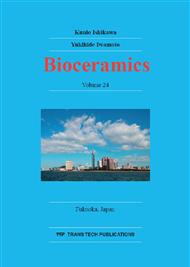p.553
p.559
p.565
p.570
p.574
p.580
p.584
p.589
p.595
Titanium and Ti-13Nb-13Zr Alloy Porous Implants Obtained by Space-Holder Technique with Addition of Albumin
Abstract:
Titanium and its alloys are the main metals studied as porous metallic implants by their excellent mechanical properties and biological interactions. Production methods of porous metallic materials are based on powder metallurgy (PM), because it allows the manufacturing of parts with complex shapes and dimensions close to the finals (near-net shape), and the addition of alloying elements reaching a satisfactory structural homogeneity, and porosity. The pore production by space-holder technique constitutes of mixing organic compounds with metal powder, which when removed by thermal treatment prior structures are kept in place. The objective of this study is to obtain porous implants of commercially pure titanium (cpTi) and Ti-13Nb-13Zr alloy by PM with space-holder technique and albumin as an additive. For the processing of the samples were used hydride titanium powder (TiH2) to obtain cpTi samples, and metal powders of Ti, Nb and Zr in the stoichiometric proportions for obtaining the alloy samples. The samples were prepared by mixing the metallic powder to the albumin (30wt%) and filling a silicone model that was pressed isostatically (140 MPa). The thermal treatment was performed in an oxidizing atmosphere (350°C/1h) for the decomposition of organic material. The sintering was performed at a temperature of 1300°C (1h/cpTi, 3h/Alloy) in high vacuum furnace (10-5 mBar) to all samples. The calculated porosity showed a significant difference between the samples cpTi (40%) and alloy (60%). The samples surface characterization showed very rough with high specific surface area. Samples of cpTi presented formation of necks arising from sintering. In the alloy samples were observed homogenous microstructure with the presence of α and β phases composing the Widmanstätten structure. It is possible to conclude that the same amount albumin allowed the formation of pores in the microstructure of cpTi and alloy although in different proportions, without harming the sintering of both and allowing diffusion of the alloy elements.
Info:
Periodical:
Pages:
574-579
Citation:
Online since:
November 2012
Price:
Сopyright:
© 2013 Trans Tech Publications Ltd. All Rights Reserved
Share:
Citation:


